Drivers and Management of Nutrient Overload in Dams: Insights from Roodeplaat Dam, South Africa
Abstract
1. Introduction
2. Materials and Methods
2.1. Study Area Description
2.2. Data Collection
- Site A captures contributions from Edendalespruit, influenced by agricultural runoff and small settlements.
- Site B reflects upstream inputs from Pienaars River, including effluent from Baviaanspoort WWTW and upstream land use impacts.
- Site C represents inputs from Hartbeesspruit and Moreleta Rivers, reflecting mixed urban and agricultural influences.
- Site D assesses direct effluent contributions from the Zeekoegat WWTW.
- Site E captures the cumulative effects of all inputs, representing the dam’s outflow and its impact on downstream users.
- (a)
- Image acquisition
- (b)
- Pre-processing
- (c)
- Classification and analysis
- (d)
- Change detection
- (e)
- Validation and mapping
2.3. Mixed Models and Principal Component Analysis
2.4. Comprehensive Pollution Index
- Category 1: CPI < 0.20 (pristine).
- Category 2: CPI from 0.21–0.40 (less polluted).
- Category 3: CPI from 0.4–1.00 (slightly polluted).
- Category 4: CPI from 1.01–2.00 (moderately polluted).
- Category 5: CPI > 2.01 (heavily polluted).
2.5. Estimation of Flows and Nutrient Loads Using Duration Curves
- Rank Flows: Daily average flow values were ranked in descending order, from the largest to the smallest, across the period of record.
- Assign Ranks: Each discharge value was assigned a rank (M), starting with 1 for the highest flow.
- Calculate Exceedance Probability: The probability (P) that a given flow would be equaled or exceeded was calculated using Equation (4).where P is the exceedance probability, M is the assigned rank, and n is the total number of flow measurements.
- High flows (0–10%)
- Moist conditions (10–40%)
- Mid-range conditions (40–60%)
- Dry conditions (60–90%)
- Low flows (90–100%)
2.6. Coupled Model Inter-Comparison Project Projections
- Projected Mean: Represents expected climate conditions under specific SSPs.
- Anomaly (Change): Highlights deviations from historical baselines.
3. Results
3.1. Spatial and Temporary Variation in Nutrient Loads
3.2. Comprehensive Pollution Index for Loads
3.3. Nutrient Load Estimation Using Duration Curves
3.4. Land Cover and Land Use Change over Time
4. Discussion
4.1. Implications for Nutrient Load Reduction
4.2. Implications for Environmental Policies
4.3. Policy Implementation Challenges and Recommendations
4.4. Climate Change Scenario: Considerations for Future Research
4.5. Key Findings
4.6. Limitations and Future Research Directions
5. Conclusions
Author Contributions
Funding
Data Availability Statement
Acknowledgments
Conflicts of Interest
Abbreviations
| ANZECC | Australian and New Zealand Conservation Council and the Agricultural and Resource Management Council for Australia and New Zealand |
| CCME | Canadian Council of Ministers for the Environment |
| CMIP | Coupled Model Inter-comparison Project |
| COD | Chemical Oxygen Demand |
| CPI | Comprehensive Pollution Index |
| DWS | Department of Water and Sanitation |
| EMSs | Earth System Models |
| FDC | Flow Duration Curve |
| IPCC | Intergovernmental Panel on Climate Change |
| LDC | Load Duration Curve |
| LEDAPS | Landsat Ecosystem Disturbance Adaptive Processing System |
| LULCC | Land Use Land Cover Change |
| N | Nitrogen |
| NBS | Nature-based Solution |
| P | Phosphorus |
| PCA | Principal Component Analysis |
| PI | Pollution Index |
| RDMs | Resource Directed Measures |
| RMSE | root mean square error |
| RQOs | Resource Quality Objectives |
| SAWQ | South African Water Quality Standard |
| SDCs | Source Directed Controls |
| SSPs | Shared Socio-economic Pathways |
| TMDLs | Total Maximum Daily Loads |
| TN | Total nitrogen |
| TP | Total phosphorus |
| TWQR | Target Water Quality Range |
| USGS | United States Geological Survey |
| VEPAC | Variance Estimation and Precision |
| WHO | World Health Organization |
| WMS | Water Management System |
| WWTW | Wastewater Treatment Works |
References
- Makanda, K.; Nzama, S.; Kanyerere, T. Assessing Feasibility of Water Resource Protection Practice at Catchment Level: A Case of the Blesbokspruit River Catchment, South Africa. Water 2023, 15, 2394. [Google Scholar] [CrossRef]
- Dubey, D.; Dutta, V. Nutrient Enrichment in Lake Ecosystem and Its Effects on Algae and Macrophytes. In Environmental Concerns and Sustainable Development; Shukla, V., Kumar, N., Eds.; Springer: Singapore, 2020. [Google Scholar]
- Noori, R.; Berndtsson, R.; Franklin Adamowski, J.; Rabiee Abyaneh, M. Temporal and depth variation of water quality due to thermal stratification in Karkheh Reservoir, Iran. J. Hydrol. Reg. Stud. 2018, 19, 279–286. [Google Scholar] [CrossRef]
- Wei, Z.; Yu, Y.; Yi, Y. Spatial distribution of nutrient loads and thresholds in large shallow lakes: The case of Chaohu Lake, China. J. Hydrol. 2022, 613, 128466. [Google Scholar] [CrossRef]
- Rathore, S.; Chandravanshi, P.; Chandravanshi, A.; Jaiswal, K. Eutrophication: Impacts of Excess Nutrient Inputs on Aquatic Ecosystem. OSR-JAVS 2016, 9, 89–96. [Google Scholar] [CrossRef]
- Pranta, A.D.; Rahaman, M.d.T.; Ahmed, M.d.S.; Rafi, M.d.S.A. Navigating Eutrophication in Aquatic Environments: Understanding Impacts and Unveiling Solutions for Effective Wastewater Management. Res. Ecol. 2023, 5, 11–18. [Google Scholar] [CrossRef]
- Njagi, D.M.; Routh, J.; Odhiambo, M.; Luo, C.; Basapuram, L.G.; Olago, D.; Klump, V.; Stager, C. A century of human-induced environmental changes and the combined roles of nutrients and land use in Lake Victoria catchment on eutrophication. Sci. Total Environ. 2022, 835, 155425. [Google Scholar] [CrossRef]
- Yang, X.; Jiang, Y.; Deng, X.; Zheng, Y.; Yue, Z. Temporal and Spatial Variations of Chlorophyll a Concentration and Eutrophication Assessment (1987–2018) of Donghu Lake in Wuhan Using Landsat Images. Water 2020, 12, 2192. [Google Scholar] [CrossRef]
- Sirunda, J.; Oberholster, P.; Wolfaardt, G.; Botes, M.; Truter, C. The Assessment of Phytoplankton Dynamics in Two Reservoirs in Southern Africa with Special Reference to Water Abstraction for Inter-Basin Transfers and Potable Water Production. Water 2021, 13, 3045. [Google Scholar] [CrossRef]
- Hwang, S.J. Eutrophication and the Ecological Health Risk. Int. J. Environ. Res. Public Health 2020, 17, 6332. [Google Scholar] [CrossRef]
- Naderian, D.; Noori, R.; Heggy, E.; Bateni, S.M.; Bhattarai, R.; Nohegar, A.; Sharma, S. A water quality database for global lakes. Resour. Conserv. Recycl. 2024, 202, 107401. [Google Scholar] [CrossRef]
- Fetahi, T. Eutrophication of Ethiopian water bodies: A serious threat to water quality, biodiversity and public health. Afr. J. Aquat. Sci. 2019, 44, 303–312. [Google Scholar] [CrossRef]
- Akinnawo, S.O. Eutrophication: Causes, consequences, physical, chemical and biological techniques for mitigation strategies. Environ. Chall. 2023, 12, 100733. [Google Scholar] [CrossRef]
- Kirk, L.; Compton, J.E.; Neale, A.; Sabo, R.D.; Christensen, J. Our national nutrient reduction needs: Applying a conservation prioritization framework to US agricultural lands. J. Environ. Manag. 2024, 351, 119758. [Google Scholar] [CrossRef] [PubMed]
- Thornton, J.A.; Harding, W.R.; Dent, M.; Hart, R.C.; Lin, H.; Rast, C.L.; Rast, W.; Ryding, S.-O.; Slawski, T.M. Eutrophication as a ‘wicked’ problem. Lakes Reserv. Sci. Policy Manag. Sustain. Use 2013, 18, 298–316. [Google Scholar] [CrossRef]
- Verlicchi, P.; Grillini, V. Surface Water and Groundwater Quality in South Africa and Mozambique—Analysis of the Most Critical Pollutants for Drinking Purposes and Challenges in Water Treatment Selection. Water 2022, 12, 305. [Google Scholar] [CrossRef]
- Patil, R.; Wei, Y.; Pullar, D.; Shulmeister, J. Effects of change in streamflow patterns on water quality. J. Environ. Manag. 2022, 302, 113991. [Google Scholar] [CrossRef]
- Nkosi, M.; Mathivha, F.I.; Odiyo, J.O. Impact of Land Management on Water Resources, a South African Context. Sustainability 2021, 13, 701. [Google Scholar] [CrossRef]
- Welde, K.; Gebremariam, B. Effect of land use land cover dynamics on hydrological response of watershed: Case study of Tekeze Dam watershed, northern Ethiopia. Int. Soil Water Conserv. Res. 2017, 5, 1–16. [Google Scholar] [CrossRef]
- Truneh, L.A.; Matula, S.; Báťková, K. An analysis of the impacts of land use change on the components of the water balance in the Central Rift Valley sub-basins in Ethiopia. Sustain. Water Resour. Manag. 2024, 10, 77. [Google Scholar] [CrossRef]
- Gabiri, G.; Diekkrüger, B.; Näschen, K.; Leemhuis, C.; van der Linden, R.; Majaliwa, J.-G.M.; Obando, J.A. Impact of Climate and Land Use/Land Cover Change on the Water Resources of a Tropical Inland Valley Catchment in Uganda, East Africa. Climate 2020, 8, 83. [Google Scholar] [CrossRef]
- Mnyango, S.S.; Thwala, M.; Oberholster, P.J.; Truter, C.J. Using Multiple Indices for the Water Resource Management of a Monomictic Man-Made Dam in Southern Africa. Water 2022, 14, 3366. [Google Scholar] [CrossRef]
- Walmsley, R.; Toerien, D.; Steÿn, D. Eutrophication of Four Transvaal Dams. Water SA 1978, 4, 61–75. [Google Scholar]
- Walmsley, R.; Toerien, D.; Steÿn, D. An Introduction to the Limnology of Roodeplaat Dam. J. Limnol. Soc. South. Afr. 1978, 4, 35–52. [Google Scholar] [CrossRef]
- Silberbauer, M.; Esterhuyse, C. Poster: Parallel drainages—The urban hydrology of the Moreletaspruit. In Proceedings of the 17th SANCIAHS National Hydrology Symposium, UWC SANCIAHS, Bellville, South Africa, 1–3 September 2014. [Google Scholar]
- Bosman, H.; Kempster, P. Precipitation Chemistry of Roodeplaat Dam. Water SA 1985, 11, 157–168. [Google Scholar]
- Jones, R.A.; Lee, G.F. Impact of phosphorus load reductions on eutrophication-related water quality of Roodeplaat Dam (Reservoir), Republic of South Africa. Water SA 1984, 10, 115–120. [Google Scholar]
- Ndlela, L.L.; Oberholster, P.J.; Van Wyk, J.H.; Cheng, P.H. Bacteria as biological control agents of freshwater cyanobacteria: Is it feasible beyond the laboratory? Appl. Microbiol. Biotechnol. 2018, 102, 9911–9923. [Google Scholar] [CrossRef]
- Lukhele, T.; Msagati, T.A.M. Eutrophication of Inland Surface Waters in South Africa: An Overview. Int. J. Environ. Res. 2024, 18, 27. [Google Scholar] [CrossRef]
- Hohls, B.C.; Quibell, G.; Du Plessis, B.J.; Belcher, T. Assessment of the Implementation of the Phosphate Standard at the Baviaanspoort and the Zeekoegat Water Care Works; Report No. N/A230/01/DEQ0797; Department of Water Affairs and Forestry: Pretoria, South Africa, 1998. Available online: https://www.dws.gov.za/iwqs/roodeplaat/index.htm (accessed on 23 August 2024).
- Sukenik, A.; Kaplan, A. Cyanobacterial Harmful Algal Blooms in Aquatic Ecosystems: A Comprehensive Outlook on Current and Emerging Mitigation and Control Approaches. Microorganisms 2021, 9, 1472. [Google Scholar] [CrossRef]
- Department of Water and Sanitation. Green Drop Watch Report 2023; Department of Water and Sanitation: Pretoria, South Africa, 2023. Available online: https://ws.dws.gov.za/iris/releases/GDWR.pdf (accessed on 15 January 2025).
- Republic of South Africa. Government Notice (GN) No. 42775: Determination of Resource Quality Objectives in the Mokolo, Matlabas, Crocodile (West), and Marico Catchments in the Limpopo North West Water Management Area (WMA 01): Resource Quality Objectives and Numerical Limits. Volume 652. Government Printing Works South Africa. 18 October 2019; pp. 103–260. Available online: http://www.gpwonline.co.za (accessed on 23 August 2024).
- Department of Water Affairs and Forestry. Water Quality Sampling Manual for the Aquatic Environment; Report Number: N/0000100/DEQ/0497; Department of Water Affairs and Forestry: Pretoria, South Africa, 1997. Available online: https://www.dws.gov.za/iwqs/reports/general/Kilian_1997_Water_Quality_Sampling_Manual_for_the_Aquatic_Environment.pdf (accessed on 15 September 2024).
- Water Research Commission. Quality of Domestic Water Supplies. Volume 2: Sampling Guide; WRC Report No. TT 117/99; Department of Water Affairs and Forestry, Department of Health, and Water Research Commission: Pretoria, South Africa, 2003. Available online: https://www.wrc.org.za/wp-content/uploads/mdocs/Quality%20of%20Domestic%20Water%20Supplies%20Sampling%20Guide%20Vol%202.pdf (accessed on 15 September 2024).
- Magagula, M.; Atangana, E.; Oberholster, P. Assessment of the Impact of Coal Mining on Water Resources in Middelburg, Mpumalanga Province, South Africa: Using Different Water Quality Indices. Hydrology 2024, 11, 113. [Google Scholar] [CrossRef]
- Sirunda, J.; Oberholster, P.; Wolfaardt, G. Assessing the Adverse Effects of Land Use Activities on the Water Quality of Selected Sub-Saharan Africa Reservoirs Using a Combination of Water Quality Indices. Water Air Soil Pollut. 2022, 233, 267. [Google Scholar] [CrossRef]
- Oberholster, P.F.; Goldin, J.; Xu, Y.; Kanyerere, T.; Oberholster, P.J.; Botha, A.M. Assessing the adverse effects of a mixture of AMD and sewage effluent on a sub-tropical dam situated in a nature conservation area using a modified pollution index. Int. J. Environ. Res. 2021, 15, 321–333. [Google Scholar] [CrossRef]
- Son, C.T.; Giang, N.T.H.; Thao, T.P.; Nui, N.H.; Lam, N.T.; Cong, V.H. Assessment of Cau River water quality assessment using a combination of water quality and pollution indices. J. Water Supply Res. Technol. Aqua 2020, 69, 160–172. [Google Scholar] [CrossRef]
- Department of Water Affairs and Forestry. South African Water Quality Guidelines. Volumes 1: Domestic Use, 2nd ed.; Department of Water Affairs and Forestry: Pretoria, South Africa, 1996. Available online: https://www.dws.gov.za/Groundwater/documents/Pol_saWQguideFRESHDomesticusevol1.pdf (accessed on 26 August 2024).
- Department of Water Affairs and Forestry. South African Water Quality Guidelines. Volume 7: Aquatic Systems; Department of Water Affairs and Forestry: Pretoria, South Africa, 1996. Available online: https://www.dws.gov.za/iwqs/wq_guide/edited/Pol_saWQguideFRESH_vol7_Aquaticecosystems.pdf (accessed on 14 September 2024).
- World Health Organization (WHO). Nitrate and Nitrite in Drinking-Water: Background Document for Development of WHO Guidelines for Drinking-Water Quality; World Health Organization: Geneva, Switzerland, 2016; Available online: https://cdn.who.int/media/docs/default-source/wash-documents/wash-chemicals/nitrate-nitrite-background-jan17.pdf?sfvrsn=1c1e1502_4 (accessed on 23 February 2025).
- ANZECC. Australian and New Zealand Environment and Conservation Council and Agriculture and Resource Management Council of Australia and New Zealand. National water quality management strategy: Paper No. 4. In Australian and New Zealand Guidelines for Fresh and Marine Water Quality. Vol. 1: The Guidelines; Australian Water Association: Canberra, Australia, 2000. Available online: https://www.waterquality.gov.au/sites/default/files/documents/anzecc-armcanz-2000-guidelines-vol1.pdf (accessed on 26 August 2024).
- Canadian Council of Ministers of the Environment (CCME). Phosphorus: Canadian Guidance Framework for the Management of Freshwater Systems. 2004. Available online: https://ccme.ca/en/resources/water-aquatic-life (accessed on 23 February 2025).
- Eyring, V.; Bony, S.; Meehl, G.A.; Senior, C.A.; Stevens, B.; Stouffer, R.J.; Taylor, K.E. Overview of the Coupled Model Intercomparison Project Phase 6 (CMIP6) experimental design and organization. Geosci. Model. Dev. 2016, 9, 1937–1958. [Google Scholar] [CrossRef]
- Hausfather, Z. CMIP6: The Next Generation of Climate Models Explained. Carbon Brief. 2019. Available online: https://www.carbonbrief.org/cmip6-the-next-generation-of-climate-models-explained/ (accessed on 10 October 2024).
- Dlamini, S.; Gyedu-Ababio, T.K.; Slaughter, A. The Loading Capacity of the Elands River: A Case Study of the Waterval Boven Wastewater Treatment Works, Mpumalanga Province, South Africa. J. Water Resour. Prot. 2019, 11, 1049–1063. [Google Scholar] [CrossRef]
- Whitehead, P.G.; Wilby, R.L.; Battarbee, R.W.; Kernan, M.; Wade, A.J. A review of the potential impacts of climate change on surface water quality. Hydrol. Sci. J. 2009, 54, 101–123. [Google Scholar] [CrossRef]
- Modley, L.A.S.; Rampedi, I.T.; Avenant-Oldewage, A.; Van Dyk, C. A comparative study on the biotic integrity of the rivers supplying a polluted, hyper-eutrophic freshwater system: A multi-indicator approach. Ecol. Indic. 2020, 111, 105940. [Google Scholar] [CrossRef]
- Kanownik, W.; Policht-Latawiec, A.; Fudała, W. Nutrient Pollutants in Surface Water—Assessing Trends in Drinking Water Resource Quality for a Regional City in Central Europe. Sustainability 2019, 11, 1988. [Google Scholar] [CrossRef]
- Steinebach, Y. Water Quality and the Effectiveness of European Union Policies. Water 2019, 11, 2244. [Google Scholar] [CrossRef]
- Dersseh, M.G.; Steenhuis, T.S.; Kibret, A.A.; Eneyew, B.M.; Kebedew, M.G.; Zimale, F.A.; Worqlul, A.W.; Moges, M.A.; Abebe, W.B.; Mhiret, D.A.; et al. Water Quality Characteristics of a Water Hyacinth Infested Tropical Highland Lake: Lake Tana, Ethiopia. Front. Water 2022, 4, 774710. [Google Scholar] [CrossRef]
- Department of Water and Sanitation. Eutrophication Management Strategy for South Africa—Edition 2. Project Report Number 4.2, Sources Directed Studies Report Number RDM/EMP&S/00/IHS/SDS/0520. Department of Water and Sanitation: Pretoria, South Africa, 2023. Available online: https://www.dws.gov.za/WEM/DocumentsSDS.aspx (accessed on 16 February 2023).
- Song, Y.; Chen, M.; Li, J.; Zhang, L.; Deng, Y.; Chen, J. Can selective withdrawal control algal blooms in reservoirs? The underlying hydrodynamic mechanism. J. Clean. Prod. 2023, 394, 136358. [Google Scholar] [CrossRef]
- Carroll, A.; Curtis, C. Increasing nutrient influx trends and remediation options at Hartbeespoort Dam, South Africa: A mass-balance approach. Water SA 2021, 47, 210–220. [Google Scholar] [CrossRef]
- Nemutamvuni, K.; McKay, T.J.M.; Tantoh, H.B. Active citizenry, community—Based organisations and the protection of urban wetlands: The case of colbyn, Tshwane, South Africa. Glob. Ecol. Conserv. 2020, 24, e01244. [Google Scholar] [CrossRef]
- Department of Water and Sanitation. Eutrophication Management Strategy into Practice. Project Report Number 5 (Version 3). Sources Directed Studies Report Number RDM/EMSSA /00/IHS/SDS/0722. Department of Water and Sanitation: Pretoria, South Africa, 2023. Available online: https://www.dws.gov.za/WEM/DocumentsSDS.aspx (accessed on 31 January 2024).
- Quayle, L.; Dickens, C.; Graham, M.; Simpson, D.; Goliger, A.; Dickens, J.; Freese, S.; Blignaut, J. Investigation of the Positive and Negative Consequences Associated with the Introduction of Zero-Phosphate Detergents into South Africa; WRC Report no. TT 446/10. Private Bag X03, Gezina, 0031; Water Research Commission: Pretoria, South Africa, 2010; Available online: https://www.wrc.org.za/wp-content/uploads/mdocs/TT%20446%20Water%20Quality%20Management.pdf (accessed on 1 March 2023).
- Jia, H.; Yuan, Q. Removal of nitrogen from wastewater using microalgae and microalgae–bacteria consortia. Cogent Environ. Sci. 2016, 2, 1275089. [Google Scholar] [CrossRef]
- Oberholster, P.J.; Cheng, P.H.; Genthe, B.; Steyn, M. The environmental feasibility of low-cost algae-based sewage treatment as a climate change adaption measure in rural areas of SADC countries. J. Appl. Phycol. 2019, 31, 355–363. [Google Scholar] [CrossRef]
- Fältström, E.; Gustafsson, S. Upstream pollution control by water utilities in Sweden: Incentives and challenges. Water Policy 2021, 23, 1400–1414. [Google Scholar] [CrossRef]
- Matthews, M.; Kravitz, J.; Silberbauer, M.; Christelis, C. The Integrated of Earth Observation into the National Eutrophication Monitoring Programme. WRC Report No. TT 770/18. Pretoria; 2019. Available online: www.wrc.org.za (accessed on 22 August 2024).
- Oberholster, P.J.; Steyn, M.; Botha, A.M. A Comparative Study of Improvement of Phycoremediation Using a Consortium of Microalgae in Municipal Wastewater Treatment Pond Systems as an Alternative Solution to Africa’s Sanitation Challenges. Processes 2021, 9, 1677. [Google Scholar] [CrossRef]
- Winter, K.; Mgese, S.; Nicklin, E.; Maraj, K. Treating and reusing polluted runoff from an informal settlement, South Africa. Water Pract. Technol. 2023, 18, 796–809. [Google Scholar] [CrossRef]
- Prigozhin, V.; Zheng, W.; Lee, F. Implementing Cleaner Production Technologies: General Aspects. E3S Web Conf. 2023, 392, 01006. [Google Scholar] [CrossRef]
- Bohman, B. Lessons from the regulatory approaches to combat eutrophication in the Baltic Sea region. Mar. Policy 2018, 98, 227–236. [Google Scholar] [CrossRef]
- Wang, H.; Guan, Y.; Hu, M.; Hou, Z.; Ping, Y.; Zhang, Z.; Zhang, Q.; Shang, F.; Lin, K.; Feng, C. Enhancing pollution management in watersheds: A critical review of total maximum daily load (TMDL) implementation. Environ. Res. 2025, 264, 120394. [Google Scholar] [CrossRef]
- Harding, W.R. A Feasibility Evaluation of the Total Maximum Daily (Pollutant) Load (TMDL) Approach for Managing Eutrophication in South African Dams; WRC Report no.2245/1/15. Private Bag X03, Gezina, 0031; Water Research Commission: Pretoria, South Africa, 2015; Available online: https://www.wrc.org.za/wp-content/uploads/mdocs/2245-1-15.pdf (accessed on 15 September 2024).
- Pienaar, H.; Xu, Y.; Braune, E.; Cao, J.; Dzikiti, S.; Jovanovic, N.Z. Implementation of groundwater protection measures, particularly resource-directed measures in South Africa: A review paper. Water Policy 2021, 23, 819–837. [Google Scholar] [CrossRef]
- Makanda, K.; Nzama, S.; Kanyerere, T. Assessing the Role of Water Resources Protection Practice for Sustainable Water Resources Management: A Review. Water 2022, 14, 3153. [Google Scholar] [CrossRef]
- Department of Water and Sanitation. National State of Water Report 2023; Integrated Water Resource Studies Report Number WII/IWRS/NSoW 2023; Department of Water and Sanitation: Pretoria, South Africa, 2024. Available online: https://www.dws.gov.za/Projects/National%20State%20of%20Water%20Report/Documents.aspx (accessed on 14 September 2024).
- Department of Water and Forestry. Water Quality Management Series, Sub-Series No. MS7, National Water Quality Management Framework Policy, Draft 2; Department of Water Affairs and Forestry: Pretoria, South Africa, 2002. Available online: https://www.gov.za/sites/default/files/gcis_document/201409/4437-2583-4-w-report-draft-2june-2002.pdf (accessed on 14 September 2024).
- Department of Water and Sanitation. Integrated Water Quality Management Policies and Strategies for South Africa: WQM Policy (Draft for Public Comments); Department of Water and Sanitation: Pretoria, South Africa, 2023. Available online: https://www.dws.gov.za/iwrp/iwqms/ (accessed on 19 November 2024).
- Kruger, A.; Pieters, R.; Horn, S.; van Zijl, C.; Aneck-Hahn, N. The role of effect-based methods to address water quality monitoring in South Africa: A developing country’s struggle. Environ. Sci. Pollut. Res. 2022, 29, 84049–84055. [Google Scholar] [CrossRef] [PubMed]
- Tong, J.; Yang, Y.; Zheng, C.; Zheng, M. Do Fiscal Incentives Contribute to Pollution Control? Empirical Evidence from China. Sustainability 2024, 16, 9632. [Google Scholar] [CrossRef]
- Kardos, M.K.; Patziger, M.; Jolánkai, Z.; Clement, A. The new urban wastewater treatment directive from the perspective of the receiving rivers’ quality. Environ. Sci. Eur. 2025, 37, 10. [Google Scholar] [CrossRef]
- Shkaruba, A.; Mnatsakanian, R.; Molodikova, I.; Kireyeu, V.; Sepp, K. Why is the eutrophication governance over the Lake of Baikal failing? Land use governance solutions need to account for barriers across sectors, scales, and actor groups. Land Use Policy 2024, 141, 107136. [Google Scholar] [CrossRef]
- Ayele, G.T.; Yu, B.; Hamilton, D.P. Land Use and Climate Change Effects on Streamflow and Nutrient Loads in a Temperate Catchment: A Simulation Study. Land 2023, 12, 1326. [Google Scholar] [CrossRef]
- Bolan, S.; Padhye, L.P.; Jasemizad, T.; Govarthanan, M.; Karmegam, N.; Wijesekara, H.; Amarasiri, D.; Hou, D.; Zhou, P.; Biswal, B.K.; et al. Impacts of climate change on the fate of contaminants through extreme weather events. Sci. Total Environ. 2024, 909, 168388. [Google Scholar] [CrossRef]
- Demir, S.; Dursun, İ. Assessment of pre- and post-fire erosion using the RUSLE equation in a watershed affected by the forest fire on Google Earth Engine: The study of Manavgat River Basin. Nat. Hazards 2024, 120, 2499–2527. [Google Scholar] [CrossRef]
- Shi, W.; Qin, B. Sediment and Nutrient Trapping by River Dams: A Critical Review Based on 15-Year Big Data. Curr. Pollut. Rep. 2023, 9, 165–173. [Google Scholar] [CrossRef]
- McGrane, S.J. Impacts of urbanisation on hydrological and water quality dynamics, and urban water management: A review. Hydrol. Sci. J. 2016, 61, 2295–2311. [Google Scholar] [CrossRef]
- Zhang, F.; Chen, Y.; Wang, W.; Jim, C.Y.; Zhang, Z.; Tan, M.L.; Liu, C.; Chan, N.W.; Wang, D.; Wang, Z.; et al. Impact of land-use/land-cover and landscape pattern on seasonal in-stream water quality in small watersheds. J. Clean. Prod. 2022, 357, 131907. [Google Scholar] [CrossRef]
- Locke, K.A. Impacts of land use/land cover on water quality: A contemporary review for researchers and policymakers. Water Qual. Res. J. 2024, 59, 89–106. [Google Scholar] [CrossRef]
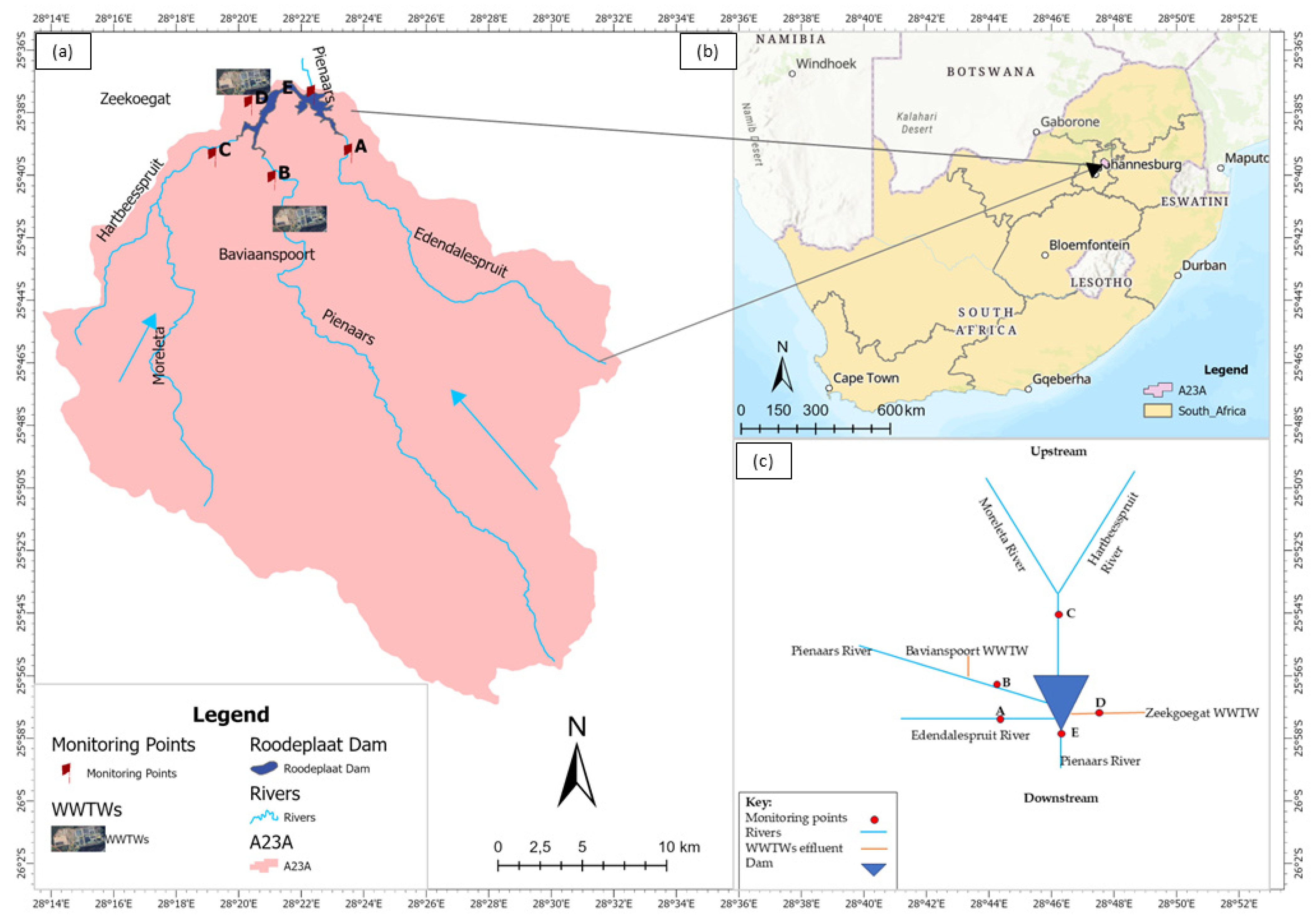
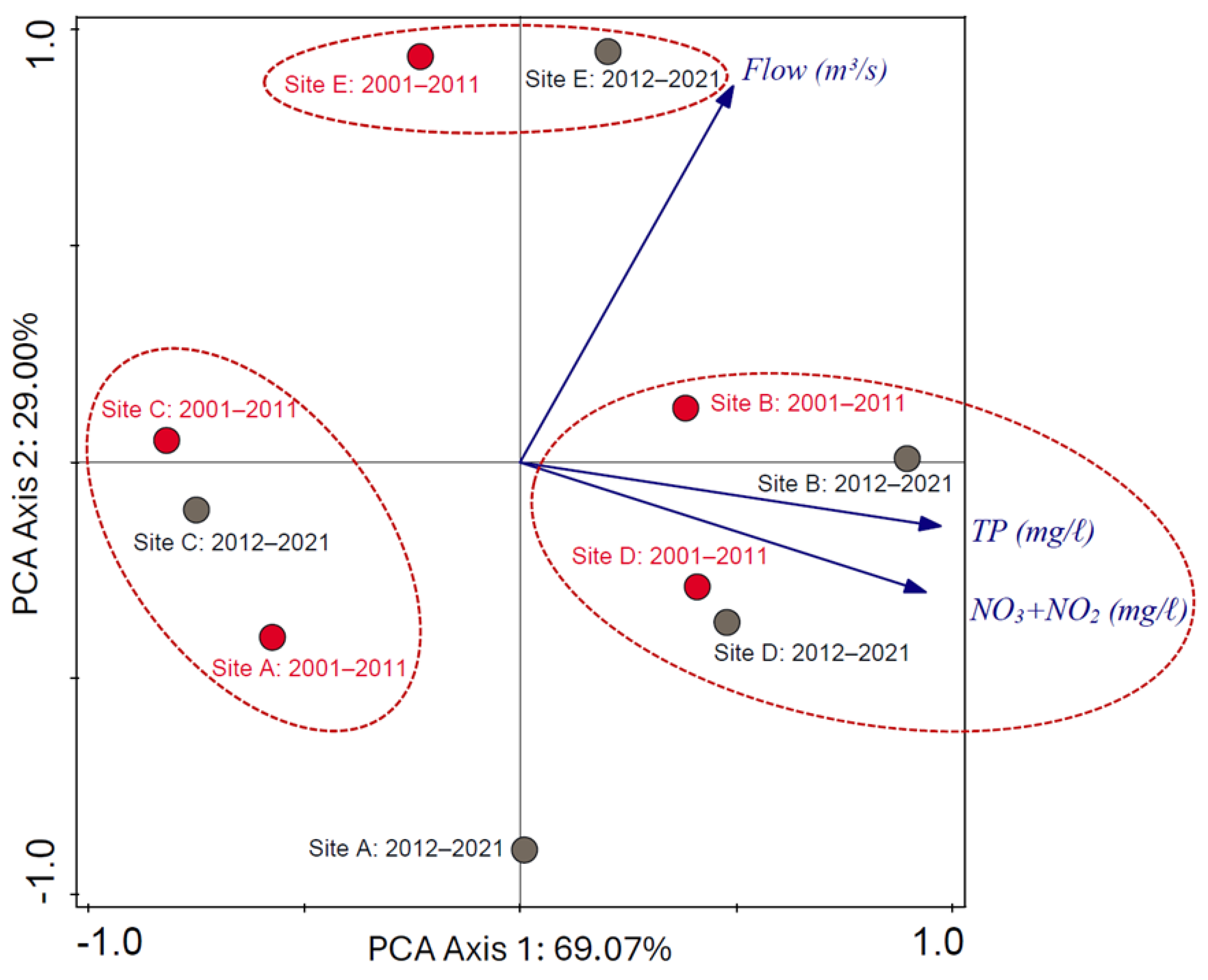
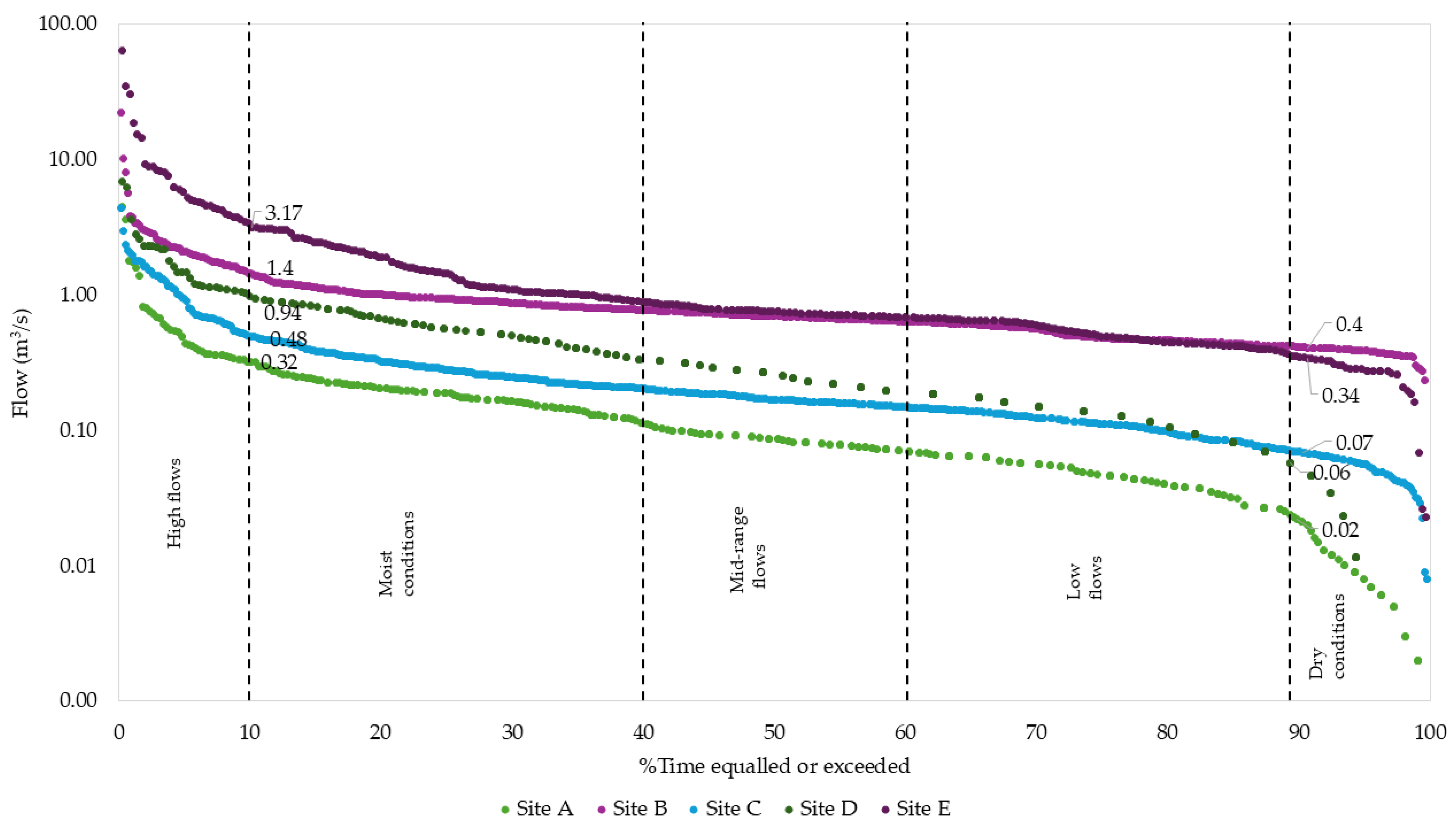
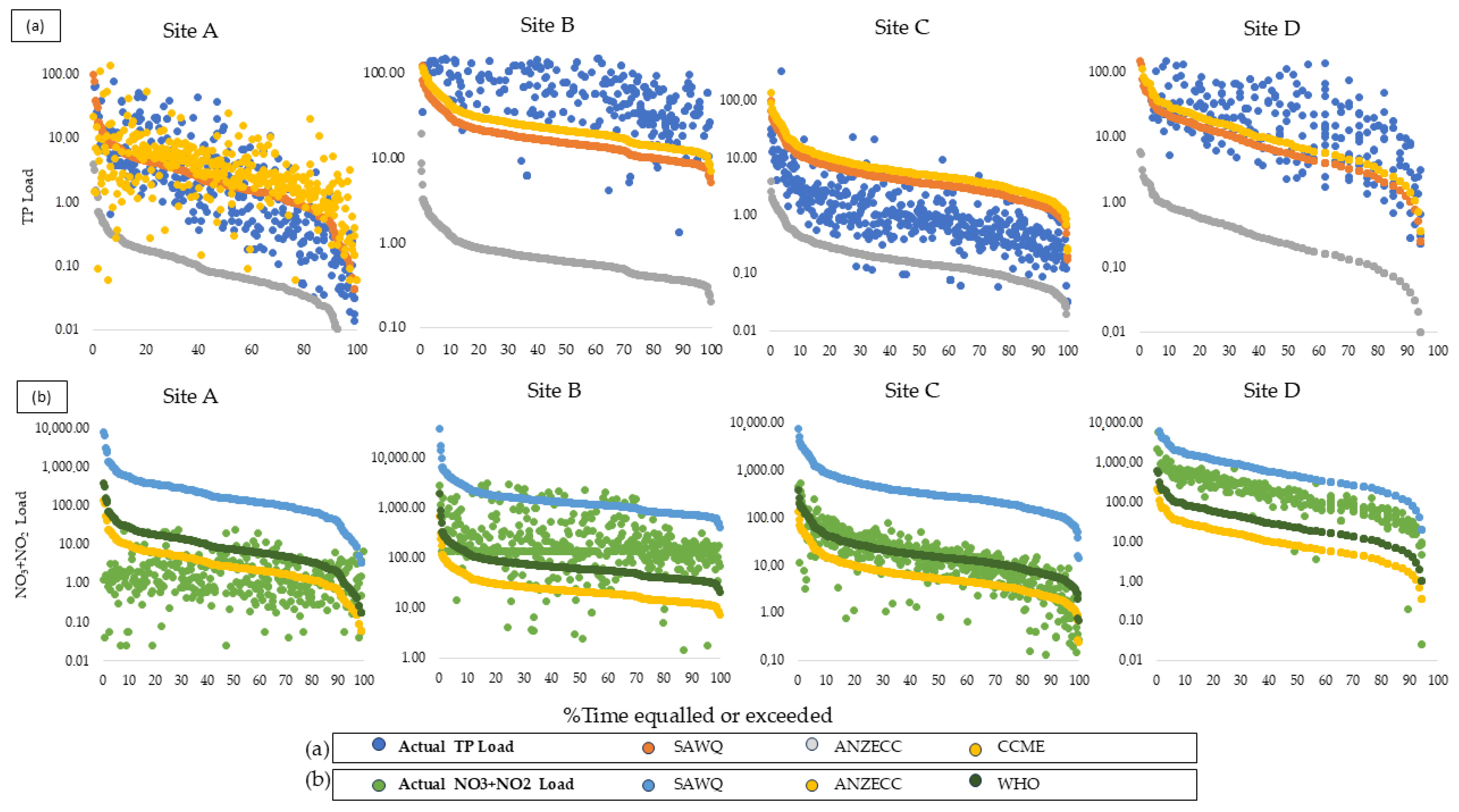
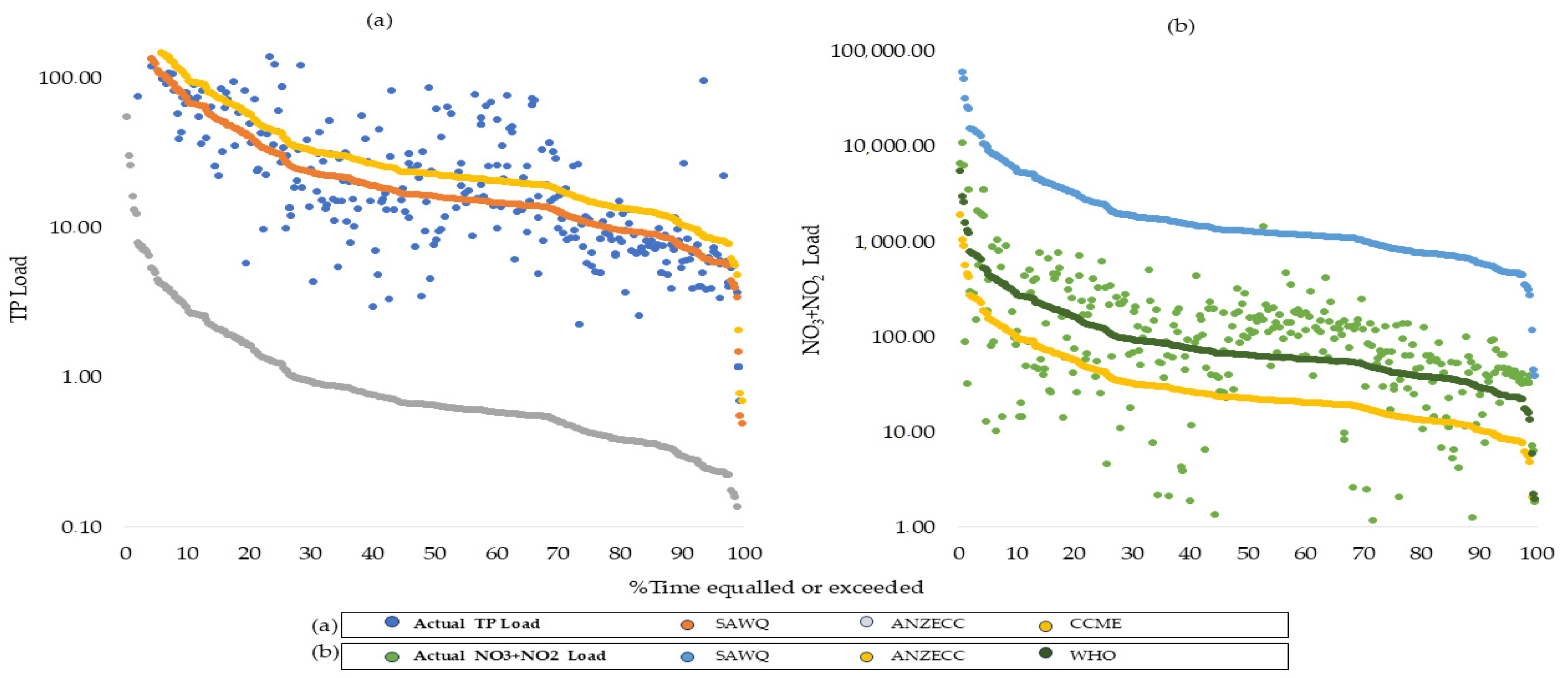
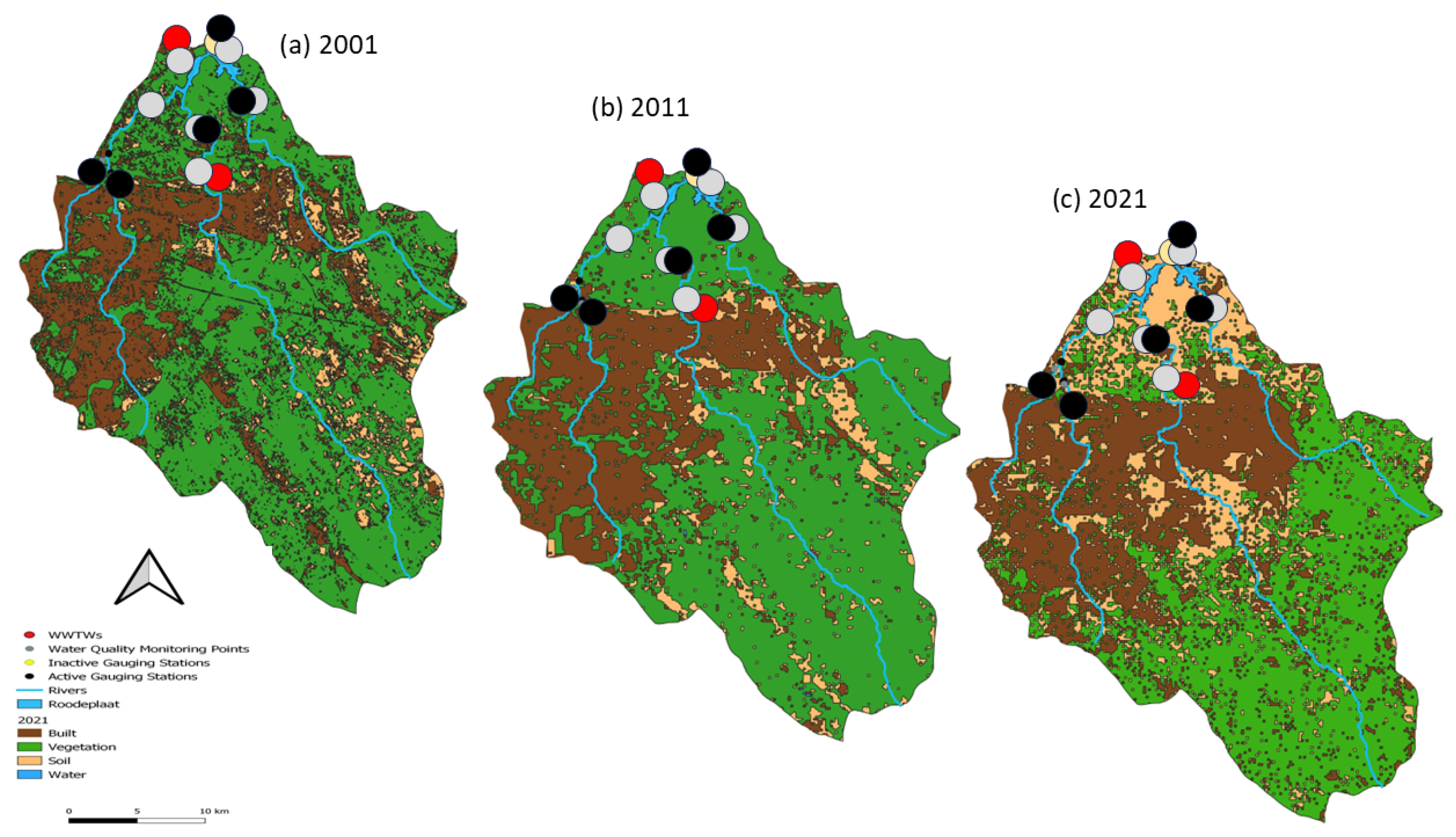
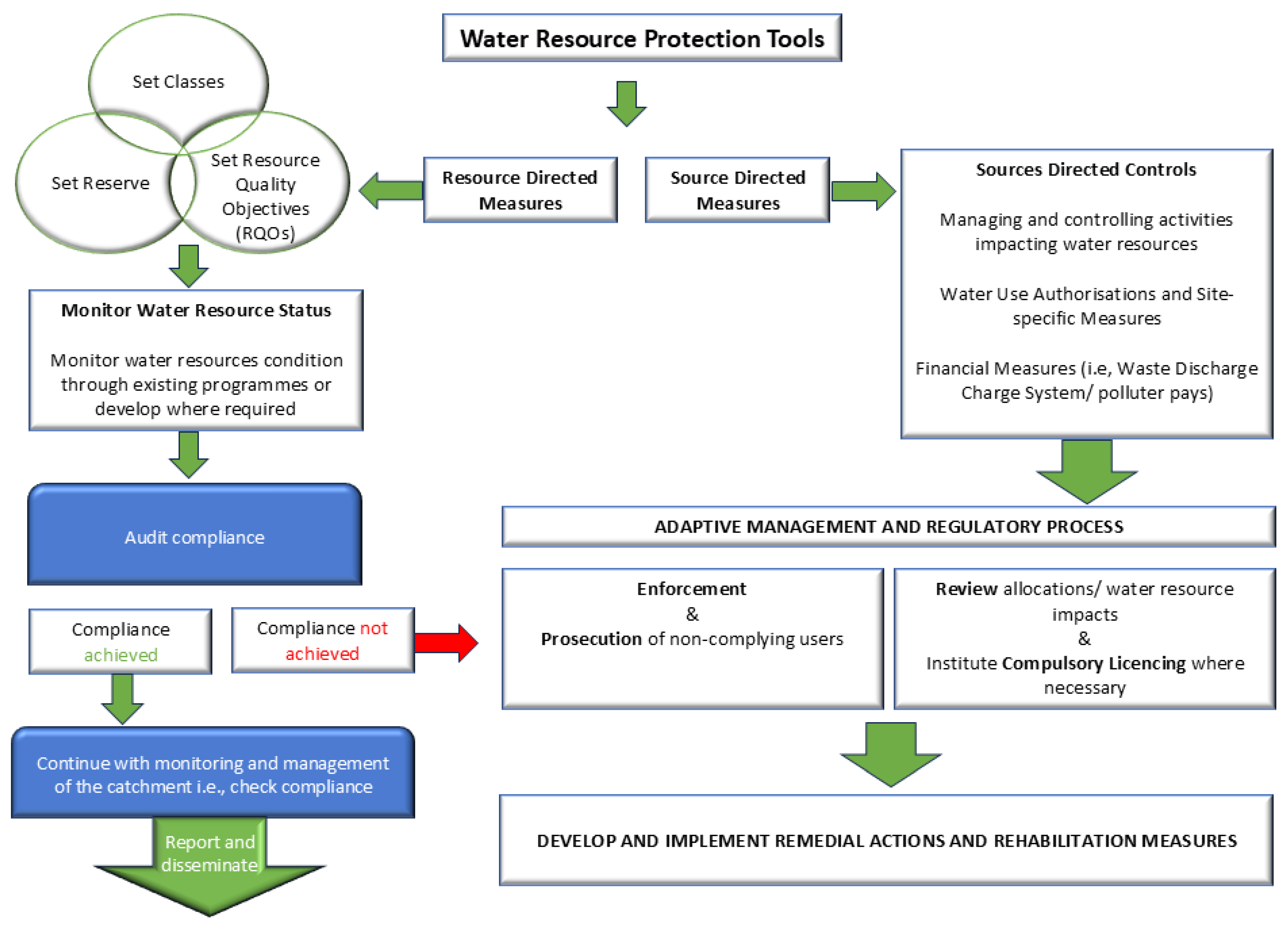
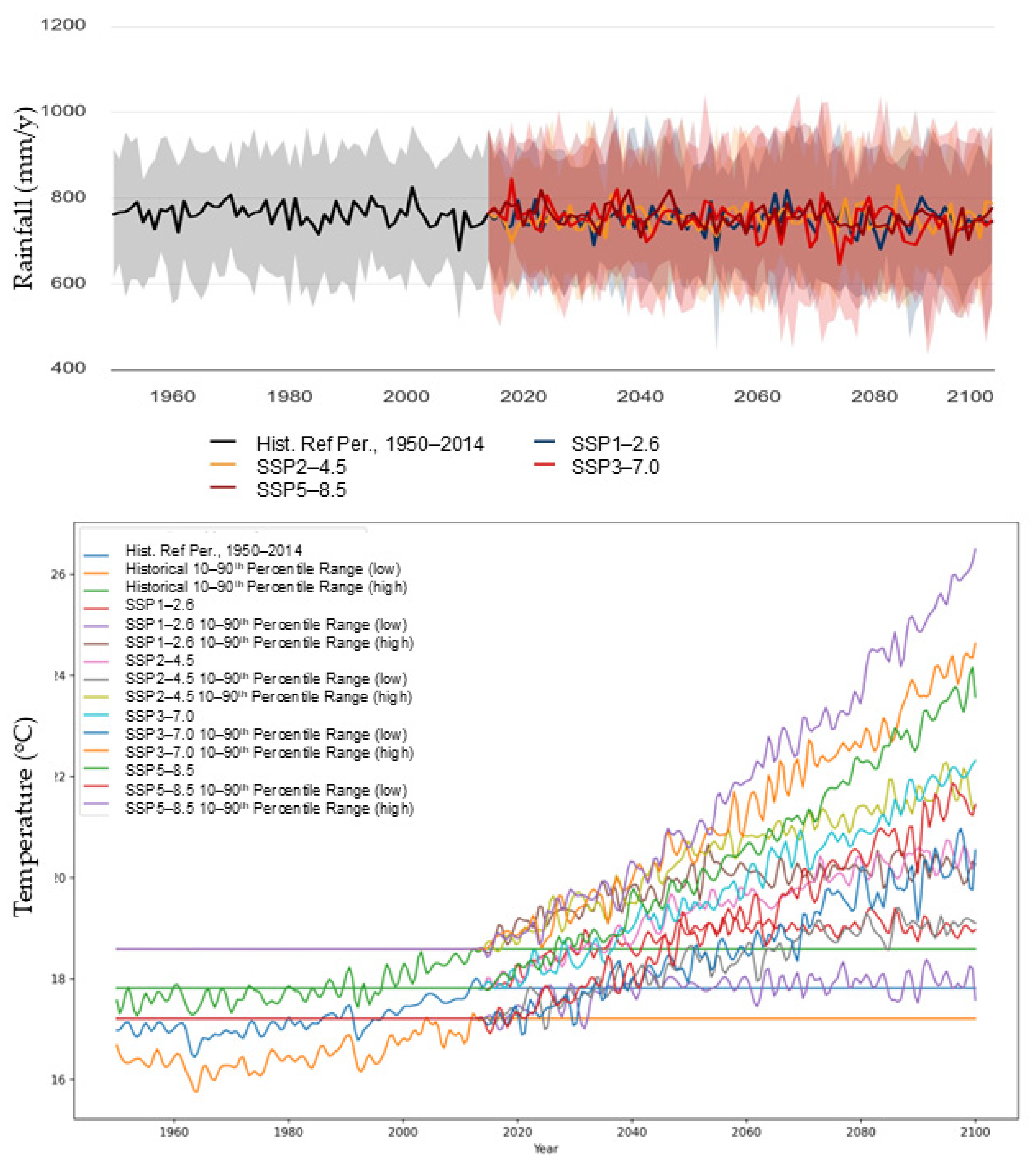
| Site ID | WMS ID | Gauging Station | Location | Coordinates |
|---|---|---|---|---|
| Inflow | ||||
| A | A2H029Q01 | A2H029 | Edendalespruit River | 28.391944; −25.648889 |
| B | A2H027Q01 | A2H027 | Pienaars River (upstream) | 28.351147; −25.663172 |
| C * | A2H028Q01 | A2H055 | Moreleta River | 28.319444; −25.66317222 |
| A2H054 | Hartbeesspruit River | |||
| D ** | A2H124Q01 | A2H124 | Zeekoegat WWTW effluent | 28.3721; −25.6177 |
| Outflow | ||||
| E *** | AR2900Q01 | AR2900 | Dam Wall | 28.33873861; −25.62319861 |
| A2H102Q01 | A2H102 | Pienaars River (releases and spills) | ||
| A2H100 Q01 | A2H100 | left canal | ||
| A2H101 Q01 | A2H101 | left canal to the right bank | ||
| Parameters | Unit | SAWQ | WHO | ANZECC | CCME | Water Use |
|---|---|---|---|---|---|---|
| TP | mg/ℓ | I: ≤0.005 | 0.01 | >0.35 * | Aquatic Ecosystem | |
| A: 0.005–0.025 | - | |||||
| T: 0.025–0.25 | ||||||
| U: >0.25 | ||||||
| NO3 + NO2 | mg/ℓ | I: ≤6 | >1 | 0.35 | - | Domestic Use |
| A: 6–10 | ||||||
| T: 10–20 | ||||||
| U: >20 |
| Site ID | Monitoring Sites | Parameters | PI | CPI | Polluted |
|---|---|---|---|---|---|
| A | Endendalespruit River | TP | 1.569771 | 0.847748 | Slightly polluted |
| NO3 + NO2 | 0.125726 | ||||
| B | Pienaars River (upstream) | TP | 6.41 | 3.369788 | Heavily polluted |
| NO3 + NO2 | 0.33199 | ||||
| C | Hartbeesspruit River | TP | 0.34627 | 0.196499 | Less polluted |
| NO3 + NO2 | 0.046728 | ||||
| D | Zeekoegat WWTW effluent | TP | 4.95 | 2.621479 | Heavily polluted |
| NO3 + NO2 | 0.29 | ||||
| E | Pienaars River (downstream) | TP | 1.374272 | 0.729337 | Slightly polluted |
| NO3 + NO2 | 0.084403 |
| LULCC Type | 2011 | 2001 | 2021 | |||
|---|---|---|---|---|---|---|
| Shape Area | % | Shape Area | % | Shape Area | % | |
| Built | 181,182,792.23 | 26.56 | 191,564,769.75 | 28.08 ⮉ | 220,475,320.57 | 32.32 ⮉ |
| Soil | 69,902,204.11 | 10.25 | 57,930,723.95 | 8.49 ⮋ | 150,154,974.47 | 22.01 ⮉ |
| Vegetation | 427,206,265.57 | 62.62 | 429,469,579.45 | 62.95 ⮉ | 308,134,324.87 | 45.17 ⮋ |
| Water | 3,897,785.67 | 0.57 | 3,223,974.42 | 0.47 ⮋ | 3,424,427.67 | 0.50 ⮉ |
Disclaimer/Publisher’s Note: The statements, opinions and data contained in all publications are solely those of the individual author(s) and contributor(s) and not of MDPI and/or the editor(s). MDPI and/or the editor(s) disclaim responsibility for any injury to people or property resulting from any ideas, methods, instructions or products referred to in the content. |
© 2025 by the authors. Licensee MDPI, Basel, Switzerland. This article is an open access article distributed under the terms and conditions of the Creative Commons Attribution (CC BY) license (https://creativecommons.org/licenses/by/4.0/).
Share and Cite
Mnyango, S.S.; Thwala, M.; Truter, C.; Xulu, N.G.; Schoeman, Y.; Oberholster, P.J. Drivers and Management of Nutrient Overload in Dams: Insights from Roodeplaat Dam, South Africa. Hydrology 2025, 12, 57. https://doi.org/10.3390/hydrology12030057
Mnyango SS, Thwala M, Truter C, Xulu NG, Schoeman Y, Oberholster PJ. Drivers and Management of Nutrient Overload in Dams: Insights from Roodeplaat Dam, South Africa. Hydrology. 2025; 12(3):57. https://doi.org/10.3390/hydrology12030057
Chicago/Turabian StyleMnyango, Samkele Siphelele, Melusi Thwala, Christoff Truter, Nkosinathi Goodman Xulu, Yolandi Schoeman, and Paul Johan Oberholster. 2025. "Drivers and Management of Nutrient Overload in Dams: Insights from Roodeplaat Dam, South Africa" Hydrology 12, no. 3: 57. https://doi.org/10.3390/hydrology12030057
APA StyleMnyango, S. S., Thwala, M., Truter, C., Xulu, N. G., Schoeman, Y., & Oberholster, P. J. (2025). Drivers and Management of Nutrient Overload in Dams: Insights from Roodeplaat Dam, South Africa. Hydrology, 12(3), 57. https://doi.org/10.3390/hydrology12030057









